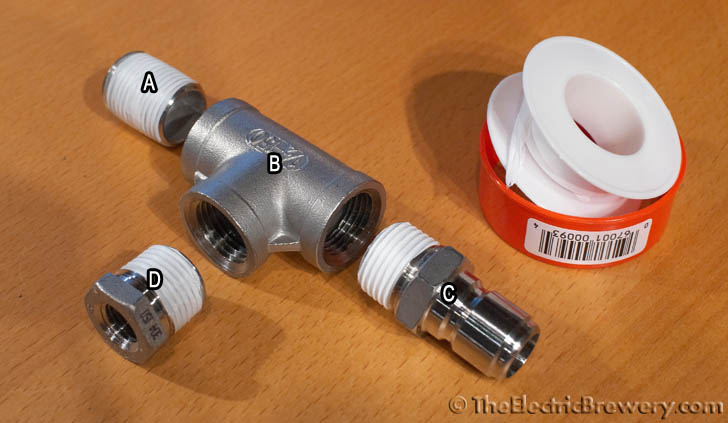Mash/Lauter Tun
STEP 2: Add a sweet wort output tee connection for the temperature probe
As the sweet wort exits the Mash/Lauter Tun through the ball valve at the bottom, a probe continuously sends a water temperature reading back to our control panel. This probe monitors the temperature of the mash so that we can see how fast (or slow) the temperature of the mash changes. It does not actually control anything in our process but instead provides feedback as to how the brewing process is proceeding.
In process control systems such as ours that involve fluid recirculating, temperature monitoring is usually done in the plumbing instead of in the kettle. This helps avoid temperature misreads due to stratification (layering). If we had placed the temperature probe in the grain (through the side of the kettle), we would only be measuring one location and would not know when the entire grain bed is at the desired target temperature as it heats slowly from top to bottom. By placing our probe at the kettle output we ensure that the entire mash temperature is being monitored. For example, when we increase the Hot Liquor Tank temperature to 168F to perform a mashout, the water in the Hot Liquor Tank will reach 168F before the grain in the Mash/Lauter Tun. It is only when the Mash/Lauter Tun also reads 168F that we know that the whole grain bed is at 168F. Placing the probe elsewhere (such as in the kettle wall) would not provide us with this accuracy.
 One other benefit of placing the probe outside the kettle is that it provides one less protrusion to get in the way of cleaning. The temperature probe we use comes with a cable that disconnects from the probe, making cleaning of the kettle much easier.
One other benefit of placing the probe outside the kettle is that it provides one less protrusion to get in the way of cleaning. The temperature probe we use comes with a cable that disconnects from the probe, making cleaning of the kettle much easier.
We use an RTD (resistive thermal device) temperature probe. Thermocouple based temperature probes are also readily available and are often used in brewing setups. While either will work, an RTD will typically be more accurate and remain more accurate (offer better linearity) over the brewing temperature range we use. RTDs also remain more accurate over time (less drift which means less re-calibration). The cost difference between the two is negligible in our setup.
Our last step is to install a tee connection to make room for this temperature probe as well as a quick disconnect so that hoses may be attached.

Breakdown of the sweet wort output tee connection parts:
(A) Stainless steel nipple threaded 1/2" x close NPT
(B) Stainless steel tee 1/2" NPT female
(C) Stainless steel male quick disconnect 1/2" NPT male
(D) Stainless steel bushing (reducer) 1/2" NPT male x 1/4" NPT female*
*Only required if a temperature probe with 1/4" NPT thread is used. If the recommended probe with 1/2" NPT thread is used, no bushing is required.

Wrap all of the threaded ends with PTFE white teflon thread sealant tape to ensure a tight, leak-free fit. Tighten using wrenches until the whole assembly is firmly attached to the kettle ball valve. Two wrenches are required: One to hold the ball valve steady to avoid it turning, the other to tighten the parts we're attaching.
There you have it! Your Mash/Lauter Tun is done!
Continue on to Building Your Brewery - Boil Kettle.
- « first
- ‹ previous
- 1
- 2
- 3
- 4






